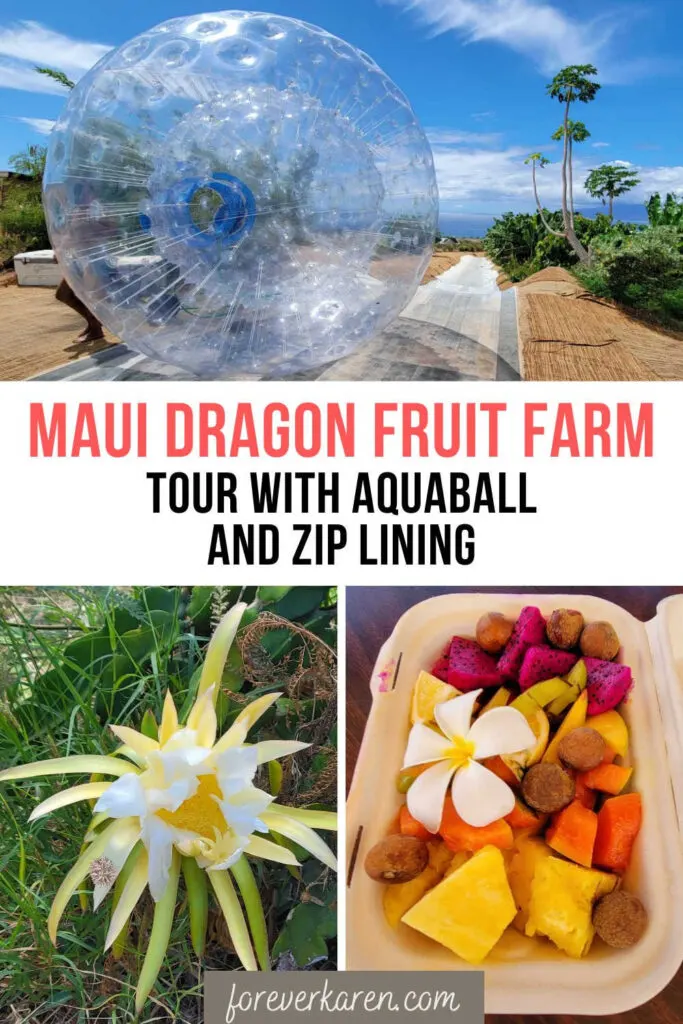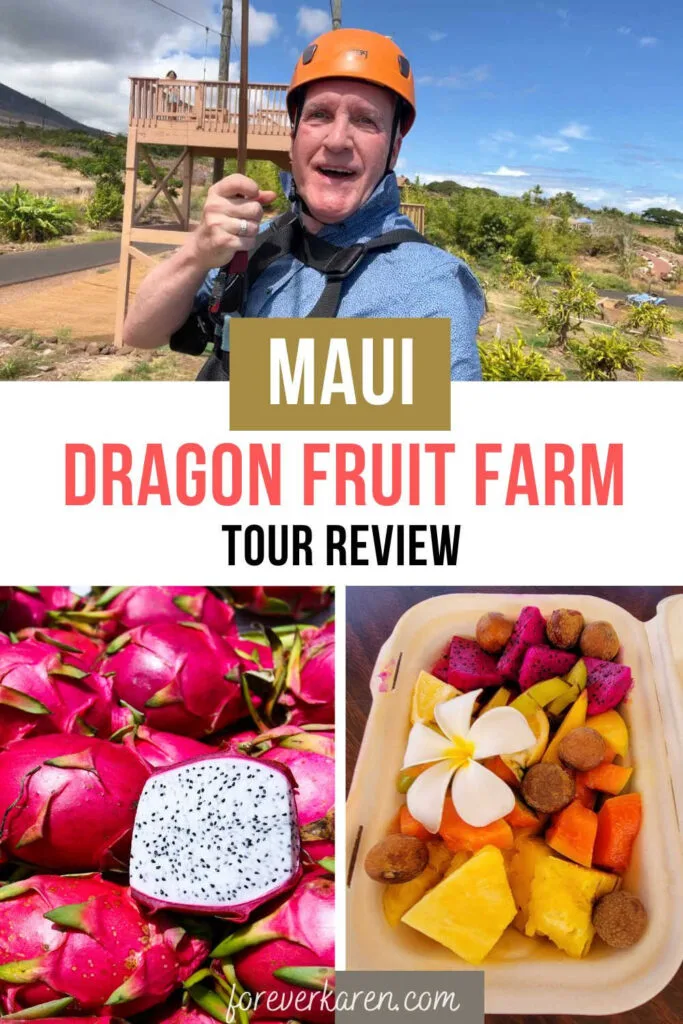
The Hawaiian archipelago has that ideal mix of hot weather and tropical rain to make everything grow. It’s no wonder it produces sugar cane, pineapples, coffee, cacao, and dragon fruit, to name a few. We cruised to Hawaii on the RCI’s Ovation of the Seas and looked forward to seeing the Maui dragon fruit farm.
While Hawaii farm tours are pretty popular, we selected the extended experience instead of just a farm tour. I wanted to try the Maui Aquaball, while my husband, Brian, chose the zip lining. Both tours included the tour of the dragon fruit farm.
Since we had been to Maui before, we wanted to try something different. This tour fit the bill and was close to the cruise port. So, whether you have 1 or more days in Maui, the tour makes a fun outing.
On our second day, we rented e-bikes in Lahaina, which included the use of snorkel gear.
Where Is The Dragon Fruit Farm?
The farm is located on a hill at 833 Punakea Loop. It’s about 5 miles outside the town of Lahaina, in west Maui.
While we originally were going to rent a car during our port day, we decided to use an Uber instead. The drive took about 15 minutes and cost USD 12.
Guests can book tours from 9 am onwards. Due to the extreme heat in Maui, the farm closes at 2 pm. Tours available are as follows:
- Dragon fruit 1-hour farm tour – USD 45 for adults, USD 35 for children (3 to 2 years), and under three are free.
- Aquaball fruit tasting tour (1-1/2 hours) – USD 119.95 for adults and USD 99.95 for children (5 to 12 years).
- Zip line fruit tasting tour (1-1/2 hours) – USD 119.95 for adults and USD 99.95 for children (5 to 12 years).
- Zip line, Aquaball, and farm tour (2-1/2 hours) – USD 189.95 for adults and USD 169.95 for children.
- Alpaca feeding and fruit tasting tour (1-1/2 hours) – USD 79.95 for adults and USD 69.95 for children.
- Alpaca feeding, fruit tasting, and sunset picnic (2 hours) – USD 119.95 for adults, USD 99.95 for children (3 to 12 years), and under three are free.
Since my husband and I were doing different activities, I accompanied him while he did zip lining and completed my aquaball afterward.
Guests participating in the aquaball or zip lining are required to sign waivers.
The Dragon Fruit Farm Tour
Arriving at the farm, we couldn’t help but admire the views. The farm is located between the majestic west Maui mountains and the ocean.
Our tour, which started at 10:30 am, had only four people. It was already scorching, so I suggest selecting a time as early as possible.
Under a pop-up tent, we signed in for our tour. The farm provides water and sunscreen if you need it. There are other water stations throughout the farm.
The farm is small and consists of 27 acres. Fifteen acres are used to cultivate exotic fruit, making it the largest organic United States dragon fruit farm.
During the walking tour, we strolled the USDA-certified organic farm and learned about trees, plants, and organic farming. This was more than a dragon fruit tour.
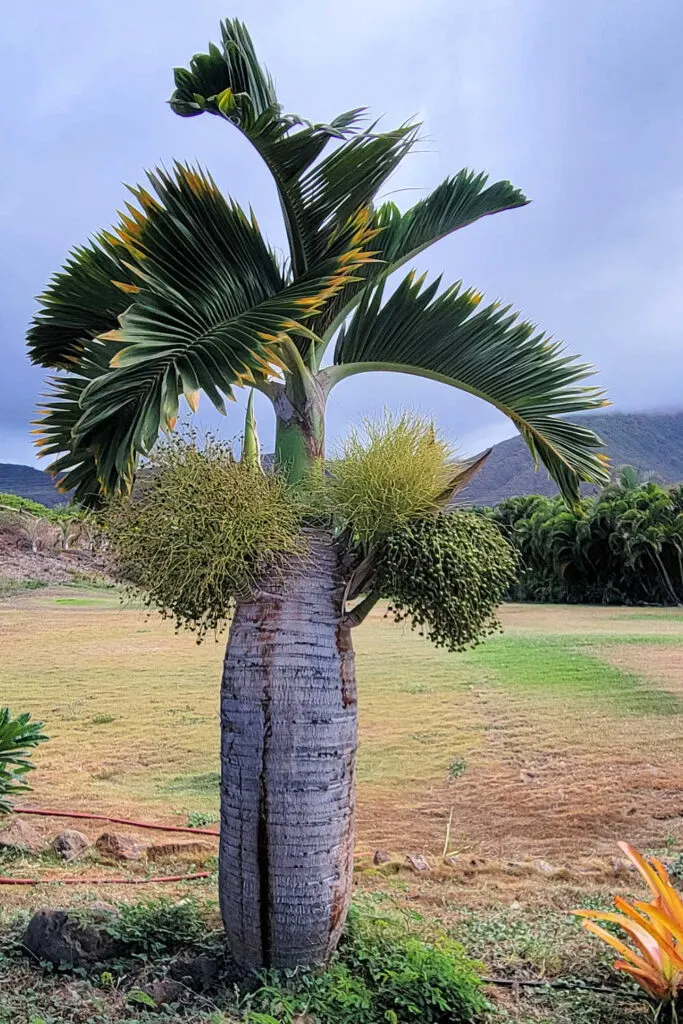
At the entrance, our tour guide explained the different palm trees. I especially liked the Bottle Palm Tree with its bulbous trunk. This tree doesn’t grow naturally but was planted by the owners.
Nearby, there were different types of Aloe and Red Ginger. Red Ginger and White Ginger are popular plants used around Hawaii hotels. They have beautiful blooms and give off a sweet fragrance.
Before we reached the dragon fruit field, we saw banana trees and pineapple plants. I was shocked to learn that a plant produces one pineapple, which takes two years to grow!
After harvesting, staff must remove the plant and plant a new one if they want it to bear fruit.
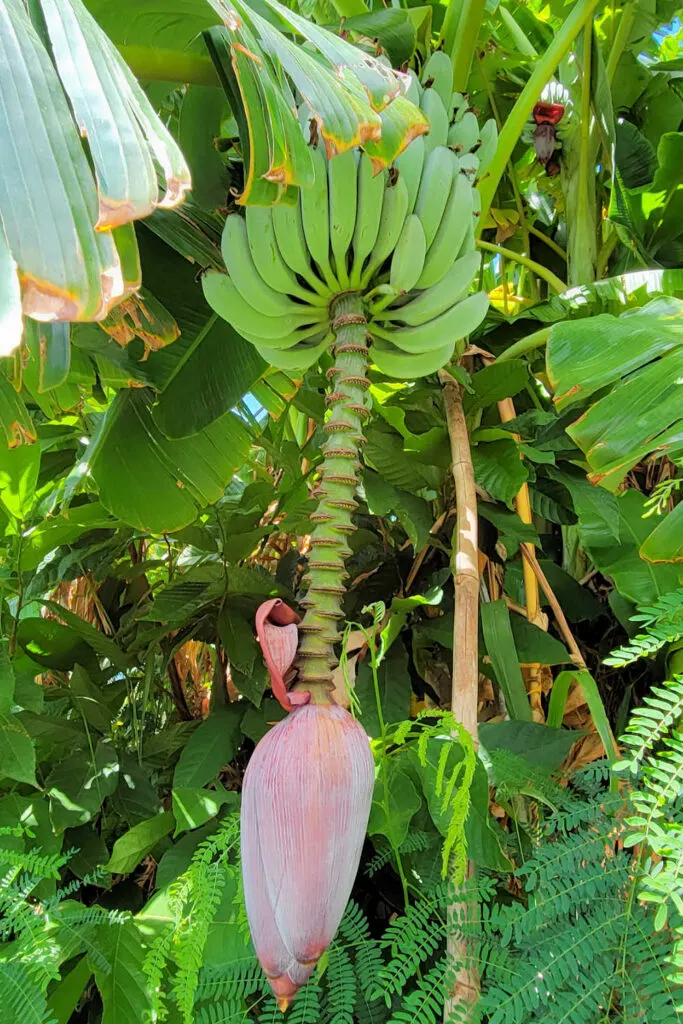
The dragon fruit farm opened in 2009. Our tour guide explained that the farm suffered a devastating fire a few years ago. The catastrophic event destroyed three of the four dragon fruit fields.
Initially, the Maui farm had 16 varieties of dragon fruit, but since the fire, they now have around 12.
Things To Know About Dragon Fruit
Dragon fruit grows from a cactus called “Hylocereus.” Growing a plant takes very little water, but they need six hours of daily sunshine.
While the skins can be red or yellow, the inside contains a juicy pulp filled with seeds (which are edible). Like the outside, the inner color can vary.
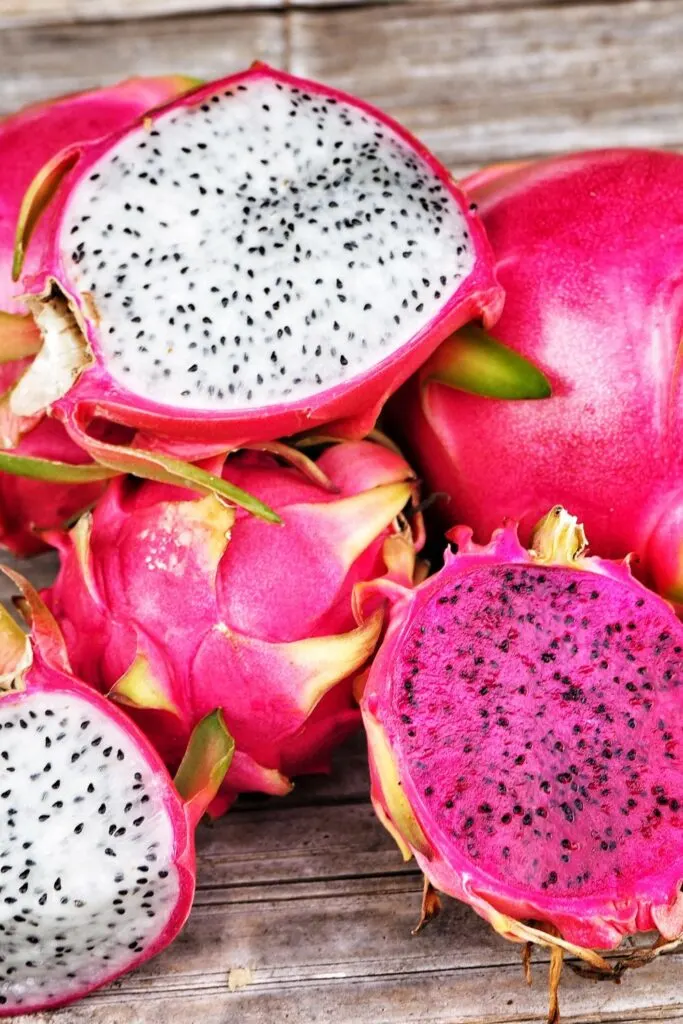
There are lots of benefits to eating dragon fruit. They are:
- High in vitamin C, which strengthens your immune system.
- Loaded with fiber and fat-free.
- They are rich in antioxidants and vitamins.
- They contain prebiotics which contribute to a healthy gut.
- A high calcium content helps promote strong teeth and bones.
- It contains Lycopene which improves heart health.
There have also been some studies to suggest that the addition of Lycopene may reduce your risk of cancer. But this hasn’t been confirmed.
Dragon fruit is best consumed raw when it’s fresh. Sometimes, it’s used in smoothies, drinks, and salads.
Learning About Dragon Fruit
Dragon fruit plants have lots of spikes. Amazingly, every point can produce a flower bud, which usually occurs during a full or new moon.
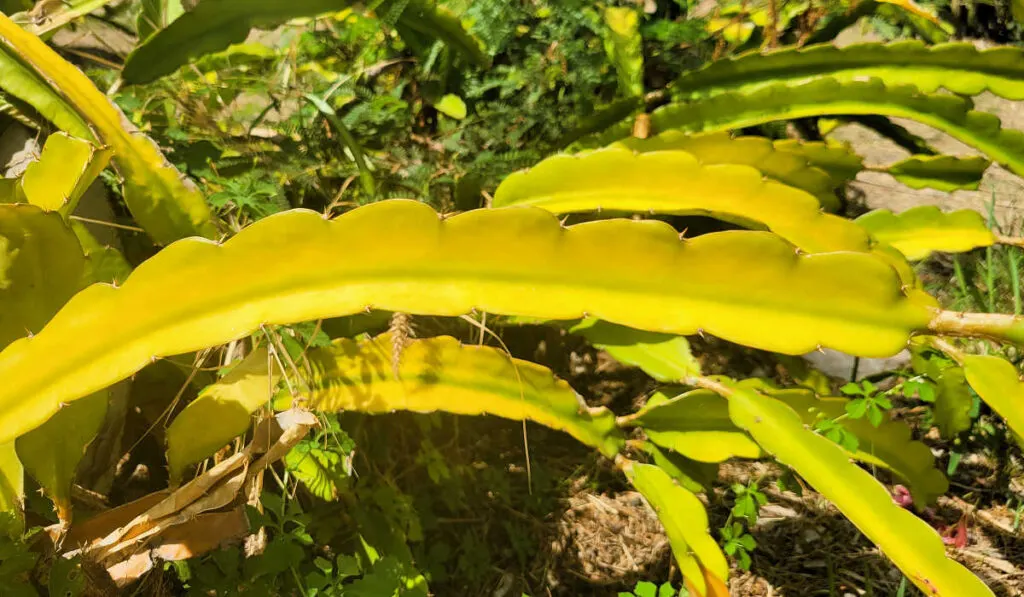
It takes 10 to 14 days for the bud to create a full flower, which, when fertilized, produces a fruit. Once fertilized, workers can harvest the bulbous fruit 6 to 8 weeks later when the fruit is a vibrant red.
Inside, most people know of the white pulp with numerous seeds. However, there are red pulp varieties too.
Once a flower grows, it will open and bloom for only ONE night. Since the blooms are both male and female, they self-pollinate. Fruit doesn’t grow well on the ground, so the plants are supported by a teepee.
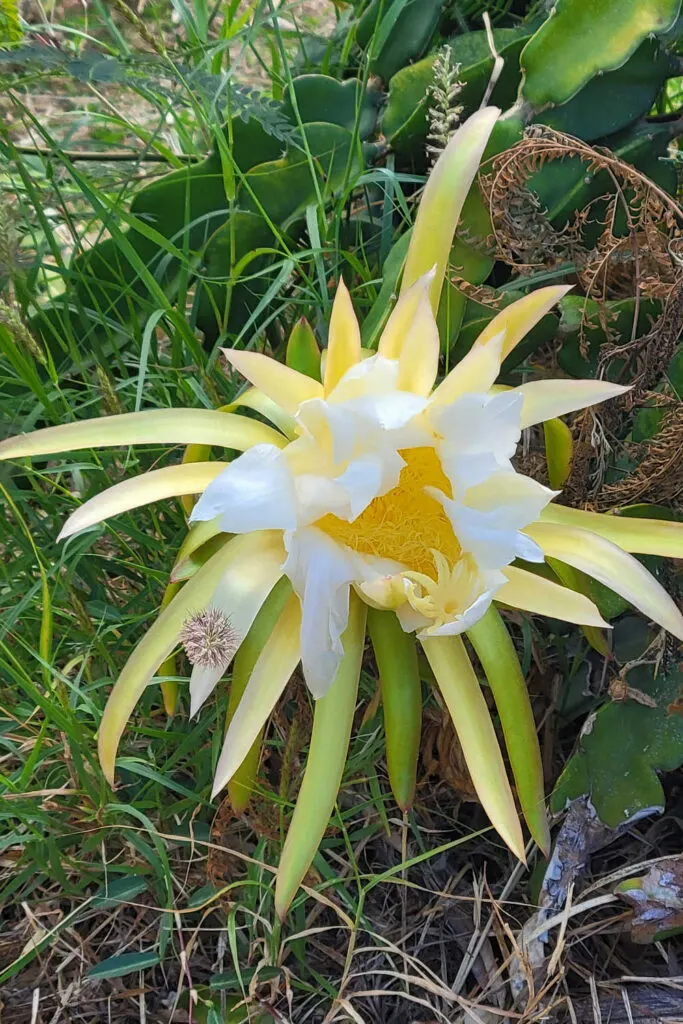
Dragon fruit is native to Indonesia, Australia, South America, Southern California, and Taiwan. In these regions, fruit bats pollinate the flowers.
Since Maui has no bats, staff must walk the fields each night with flashlights and pollinate blooming flowers with a paintbrush.
On this tour, I gained a massive appreciation for growing dragon fruit. While the cactus is easy to grow, it takes a lot of dedication and passion for pollinating the flowers each night. Dragon fruit season runs from May to November, so it’s best to plan your tour during that time.
Since we visited in early October, dragon fruits were still growing in one plot. The fruits were covered in mesh netting to protect them from being eaten by birds.

While the farm has four plots, each can produce 800 to 1,000 lbs of fruit during a growing season. We continued onto zip lining from the top plot and concluded the farm tour after my aquaball runs.
Zip Line Tour
The Maui dragon fruit farm has one zip line close to the ground. Since I had done more exciting runs in Central America, I opted to do something other than this tamer run.
Participants can do four runs, and this activity suits kids, grandparents, or adults new to zip lining. Since my husband, Brian, and another participant hadn’t done zip lining before, this was a nice alternative to trying a scarier run.
Zip lining is not recommended for those with previous back or neck injuries and women who are pregnant. The line has a maximum weight capacity of 250 lbs.

The 450-foot line runs from one elevated manufactured platform to another and hangs over the dragon fruit upper plot. After a run, a golf cart provided a ride back to the first platform again.
Zip liners wear a safety harness that runs over their shoulders and through their legs. This type of harness allows riders to hang upside down and do tricks without the risk of falling out if they are brave enough.
Riders must also wear safety helmets, and it’s advisable to wear closed-toe shoes instead of sandals.

The zip line uses one safety line (not two) and has a gravity-braking system. Non-riders can watch and take videos and photos. The riders can use a GoPro and take a smartphone during the run.
At the zip line station, there was another water container and paper cones to get hydrated.
Maui Aquaball
The aquaball activity might be one of the craziest things I’ve done, but it was such a blast. Picture crawling inside a giant hamster ball and rolling down a hill. That’s what I did.
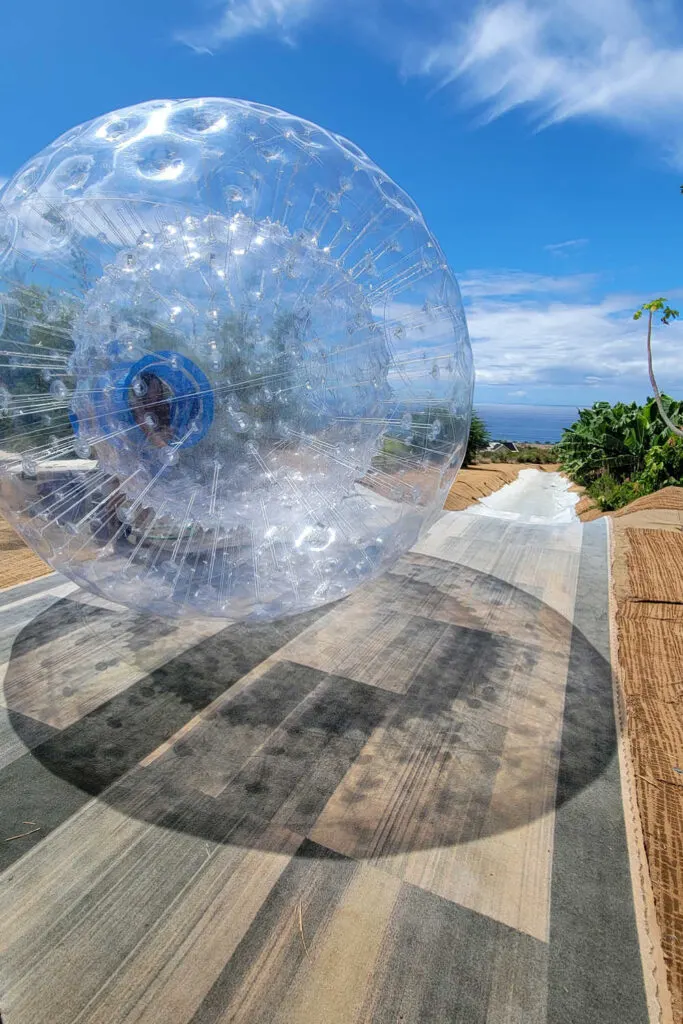
At the farm’s entrance, a clean washroom allows participants to change into a bathing suit or arrive at the farm with one under their clothes.
For USD 119.95, the adventure tour included two aquaball runs. A staff member added a few buckets of cold water inside the giant ball while I stripped down to my swimsuit.
The cold water was quite refreshing, with 34C temperatures and a hot walk through the farm.
With a GoPro in hand, I slid inside the aquaball. Next, a staff member sealed the entrance to the ball with a giant stopper. Then I was pushed off the hill to start the ball rolling (no pun intended).

Before arriving in Lahaina, I had visions of myself doing somersaults in the ball. However, the water acts as a lubricant, so I basically sloshed around in the bottom of the ball.
The ball runs on a guided shallow track and rolls slowly down the slope. Although, with the addition of water, you have no control over staying upright inside.
On my first run, I stayed facing forward in the bottom of the ball and laughed all the way down. At the bottom, I exited the ball, and an employee put the ball on the back of a truck. We then rode back to the top to rinse and repeat.
My second run was quite different than the first. Maybe because I was soaking wet? I spun and rolled like a drunk hamster in a hamster ball this time.
Our farm tour continued once I was transported back to the top of the hill.
More On The Farm Tour
Chocolate comes from cacao, which is grown in Hawaii. Cacao trees are challenging to grow and require lots of sun and humidity. We saw some cacao trees at the farm with small green pods.
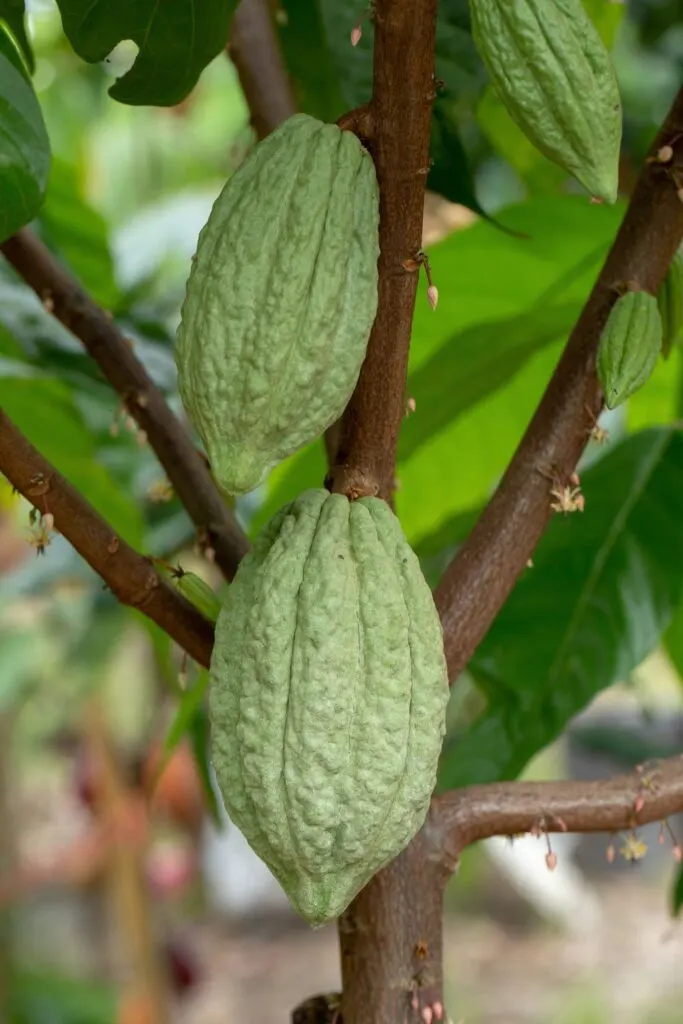
The pods are ripe when they turn to a yellow-orange color. Inside, the pod has white pulp with 20 to 50 cacao beans or seeds. You can tour Maui Ku’ia Estates if you love chocolate, which comes with free tasting.
The dragon fruit farm also has papaya trees. These are much easier to grow and produce clusters of fruit. Papaya trees come in three varieties; male, female and hermaphroditic. Only the female and hermaphroditic will produce fruit.
It takes 6 to 9 months to harvest papayas. Papaya is sweetest when the outside is yellow or orange.
From here, we headed back to the entrance, so I could change into dry clothes and sample some tropical fruit. The fruit plate was refreshing and contained a variety of Hawaiian fruit from the Maui Mountain Cafe.
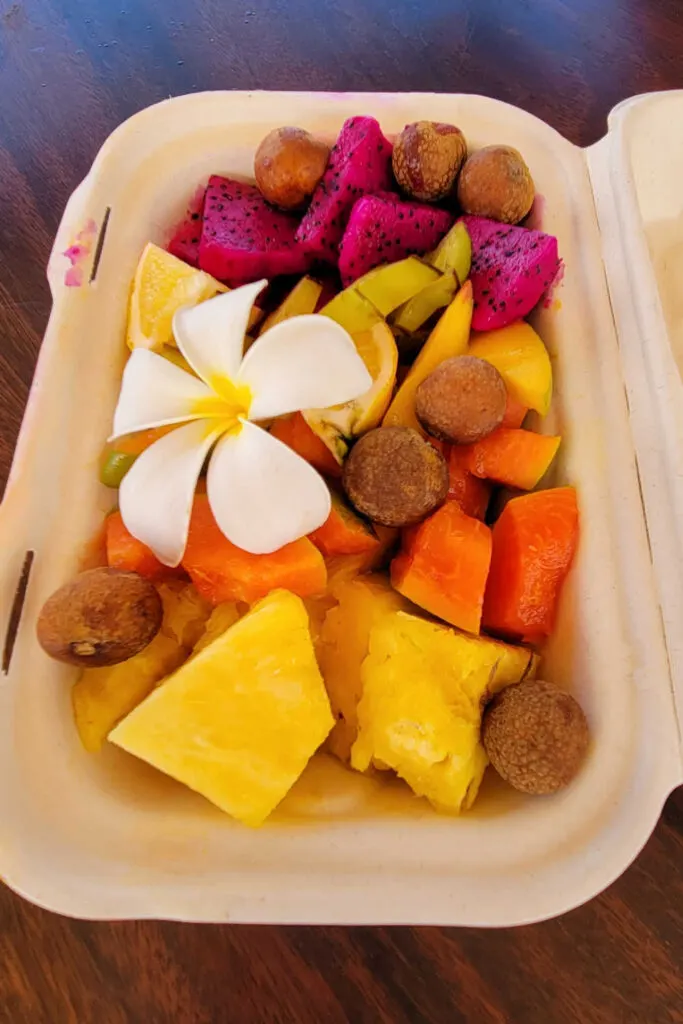
The cafe sells exotic flavored Kombucha, popsicles, and the freshest fruit sourced for the Hawaiian Islands.
We enjoyed starfruit, dragon fruit, oranges, lychees, pineapple, papaya, and mangoes. A coconut with straws allowed us to drink fresh coconut water. However, the dragon fruit lemonade was terrific.
Plate samplings may vary by what’s in season.
Conclusion
Before we went, we had read some negative reviews about visiting this Maui farm. If travelers went outside dragon fruit season, they didn’t see any fruit and never sampled it. They felt there wasn’t much to the farm tour, and I had to agree.
The farm could improve the experience by adding informational plaques with pictures when nothing is growing. The staff could share the benefits of dragon fruit. While I added a section to this article, this was sourced after my visit.
Like others, we felt the USD 132.15 per person was a bit steep for the 90-minute experience. Since we are Canadian, with the dollar exchange, that converted to CAD 360 for the two of us.
However, the tour guides were terrific and very knowledgeable.

